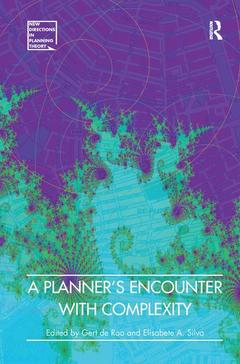Contents: Preface; Planning and complexity: an introduction, Gert de Roo; Being or becoming? That is the question! Confronting complexity with contemporary planning theory, Gert de Roo; Dealing with society's 'big messes', Jens-Peter Grunau and Walter L. Schönwandt; Complexity in spatial planning practice and theory: the case of Kiruna mining town, Kristina L. Nilsson; Complex systems, evolutionary planning?, Luca Bertolini; Complexity in city systems: understanding evolution and design, Michael Batty; Emergence, spatial order, transaction costs and planning, Chris Webster; Spatial planning processes: applying a dynamic complex systems perspective, Menno Huys and Marcel van Gils; The awakening of complexity in conceptualisations of space in planning, Janneke E. Hagens; Process and transient scenarios in collaborative planning: managing the time dimension, Adele Celino and Grazia Concilio; Complexity and cellular automaton: exploring its practical application, Elisabete A. Silva; Complexity and travel behaviour: modelling influence of social interactions on travellers' behaviour using a multi-agent simulation, Yos Sunitiyoso, Erel Avineri and Kiron Chatterjee; Complexity theory and transport planning: fractal traffic networks, Erel Avineri; Going beyond the metaphor of the machine: complexity and participatory ecological design, Joanne Tippett; Rethinking brownfields: discourses, networks and space-time, Nikos Karadimitriou, Joe Doak and Elisabete Cidre; Urban governance and social complexity, Joris van Wezemael; Waves of complexity: theory, models, and practice, Elisabete A. Silva; Index.




